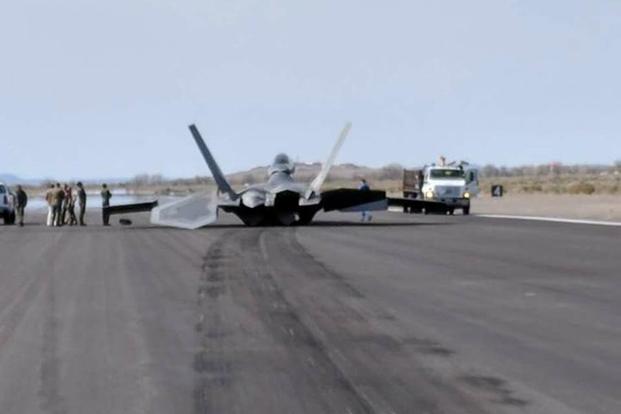An F-22 Raptor pilot taking off from Naval Air Station Fallon, Nevada, in April had incorrect takeoff data, reached inadequate airspeed and prematurely retracted the landing gear, causing the stealth jet to slide down the runway, according to a new accident report.
The jet, from the 3rd Wing at Joint Base Elmendorf-Richardson, Alaska, was taking off on a training sortie with a Navy F/A-18 Hornet for a TOPGUN basic flight maneuver exercise when the mishap occurred April 13, according to the Accident Investigation Board report released last week.
Investigators attributed the accident largely to human error with a number of factors at play, including the pilot not having the correct Takeoff and Landing Data (TOLD).
"Takeoff and Landing Data (TOLD) was not computed in accordance [with] applicable technical order data (TOD) for the conditions at NAS Fallon on the day of the mishap, and the TOLD displayed on the mishap pilot's lineup card was incorrect," the AIB report states.
Related content:
- Air Force Reports Second Mishap in 8 Days for Alaska-Based F-22s
- All F-22s Have Now Left Tyndall, Air Force Secretary Says
- F-22 Raptor Makes Emergency Landing in Alaska
Around 10:45 a.m. local time, the pilot initiated a military power takeoff and rotated at "120 knots calibrated airspeed (KCAS)," according to the report. This type of rotation occurs when the pilot initiates back stick pressure "to lift the nose of the aircraft off the ground and set the takeoff pitch attitude."
The jet continued to accelerate. At 135 KCAS, the pilot believed the plane was lifting off the ground after looking at the weight-on-wheels switches, which are designed to sense when the aircraft becomes airborne. At 142 KCAS, the pilot took the visual cues for takeoff and retracted the landing gear.
But on the day of the mishap, the rotation speed and takeoff speed should have been 143 KCAS and 164 KCAS, respectively, the report states.
"Once the [mishap pilot] recognized his visual cues for takeoff, he raised the landing gear handle to retract the landing gear. After main landing gear retraction, the [mishap aircraft] impacted the runway with all but the nose landing gear (NLG) doors fully closed," according to the report.
The Raptor slid down the runway for 6,514 feet until it came to a stop. While the report notes the pilot "failed to apply any corrections to the incorrect TOLD," the pilot did shut off both engines as the jet was skidding down the runway, decelerating during the belly flop.
Col. Jacob Trigler, head of the accident board, said four additional factors "substantially contributed to the mishap: inadequate flight brief, organizational acceptance of an incorrect technique, formal training, and organizational overconfidence in equipment."
"Most pilots acknowledge that the high thrust of [an F-22] provides confidence that the jet will easily get airborne," the report states.
Investigators cited a pilot who said the F-22 community "takes it for granted that we have a lot of power and that this jet will generally take off from any runway that you want it to take off from."
This has made pilots less reliant on Takeoff and Landing Data, which may set a dangerous precedent, according to the report.
The Air Force did not provide a cost estimate for the damage sustained by the F-22. The pilot was unharmed, and there no damage to nearby property, the report states.
-- Oriana Pawlyk can be reached at oriana.pawlyk@military.com. Follow her on Twitter at @Oriana0214.











